The pentatonic scale is, perhaps, the most-used guitar scale of all time. Yes, you can hear it in all kinds of records from rock to pop and everything in between.
That being said, the pentatonic scale is not the only scale you can play; on the contrary, it is just one of many.
The more scales you know, the more ductile you’ll be as a guitar player, and the more gigs you’ll get. In other words, information will make you a better guitarist; the kind we all want in our team.
So, in this post, we’ll take the first step in that direction and explore the differences between the blues scale and the pentatonic scale.
The difference between the pentatonic scale and the blue scale is a single note. This chromatic note is also known as the “blue note” and it doesn’t happen naturally in the major or minor scales. Also, the blues scale is hexatonic, because of this extra note.
That was the short answer, but the complete one with exercises and a lot of playing is only a few paragraphs away. So, go get your favorite blues ax and your cool hat; come front to the porch, and get ready because there’s a lot of playing to do.
Are you ready to make the most out of the blue note and engage the emotional factor with your playing?
Let’s get blue!
What is a pentatonic scale?
Let’s start by talking about the scale that the blues scale derives from: the pentatonic scale.
Why is it called the pentatonic scale? Well, because it has five notes: Penta = Five; Tonic = notes.
A cool fact about pentatonic scales is that they were developed by different civilizations across the planet. They did it independently, without having any contact.
That can partly explain why it is the most taught and most-played scale of all time. Indeed, you can hear major and minor pentatonic scales in most modern music; including all genres.
For example, just to name a few riffs you might recognize that are 100% based on the first position of the pentatonic scale:
- “Paranoid” – Black Sabbath
- “Whole Lotta Love” – Led Zeppelin
- “Jumpin’ Jack Flash” – Rolling Stones
- “Fake Tales of San Francisco” – Arctic Monkeys
- “Guerrilla Radio” – Rage Against the Machine
- “Born Under a Bad Sign” – Albert King
- “Are You Gonna Go My Way?” – Lenny Kravitz
- “Black Dog” – Led Zeppelin
- “Gravity” – John Mayer
- “Voodoo Chile” – Jimi Hendrix
And that’s only riffs if we would include solos; the list would take you days to read.
But why is this important? Well, unless you want to play any music style that’s not influenced by blues, rock, and pop, you’ll have to learn the pentatonic scale to play most hits in music history.
Yes, learning the pentatonic scale is that important.
Are there different pentatonic scales?
Now that we’ve established how important the pentatonic scale is for modern music, it’s time to learn it in all its glorious variants. Yes, we are going to go over the major and minor pentatonic scales.
Plus, every pentatonic scale features five positions that cover the entire neck.
Wait, what?! Can I play through the entire neck with a single scale?!
Yes, you can, because pentatonic scales cover the entire fretboard.
In other words, wherever position five finishes, position one starts. Therefore, you can play the scale in two octaves. This was Stevie Ray Vaughan’s trick when he played those mind-blowing open-string riffs.
A great example is the song “Scuttle Buttin’”, by SRV and Double Trouble. Here’s the video of the maestro himself playing it live.
The Major Pentatonic
Let’s begin by learning the major version of the pentatonic.
As we said before, its name comes from the fact that it’s made of five notes. Any major scale, as you might know, it’s made of 7 notes.
So, the major pentatonic scale will be a simplified version of the major scale. This is not a detail, because it’s one of the reasons why this scale is so popular.
This is the A Major Scale:
| I | II | III | IV | V | VI | VII |
| A | B | C# | D | E | F# | G |
| W | W | H | W | W | H | W |
We need to remove two notes from it because it has seven and the Pentatonic has only five.
For the major pentatonic scale, we’ll remove the IV and VII degrees.
The major pentatonic formula is:
- I (Root)
- II (Major)
- III (Major)
- V (Perfect)
- VI (Major)
This means that the pentatonic formula excludes the half-tone intervals from the major scale. This happens because we leave out the IV and VII degrees.
What does that mean? Well, it means that the major pentatonic leaves out the mild dissonance that the semi-tone distances create.
Furthermore, the VII degree causes tension that begs for release and is left out in this scale.
In other words, this scale leaves all tension out creating a happy, upbeat melody that goes well over most chord progressions.
Besides sounding good on almost anything and adding a pinch of upbeat to any song, the ease of use (we’ll see its shape in a minute, it’s very simple and playable) makes this scale a favorite for most guitar players in the world.
So, what’s the shape of our A major pentatonic scale?
A – B – C# – E – F#
| I | II | III | V | VI |
| A | B | C# | E | F# |
| W | W | W+H | W | W |
As you can see, in no case there’s a distance inferior to a whole tone between the notes.
These are the five positions of the A major pentatonic:
First Position
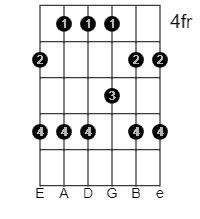
Second Position
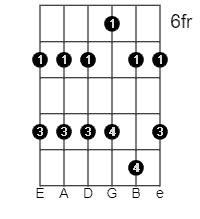
Third Position
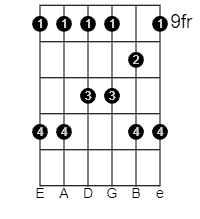
Fourth Position
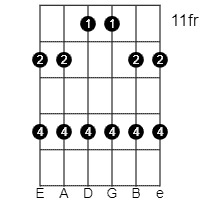
Fifth Position
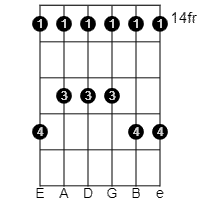
Bear in mind that you can play position five behind position one; it would be something like this:
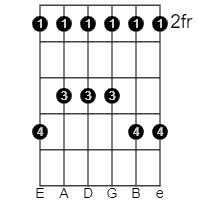
This is the A major pentatonic in all its glorious expansion with its five positions covering the entire guitar neck.
Are you ready to get emotional and check out the minor pentatonic?
The Minor Pentatonic
Now that you know how to play the five positions of the major pentatonic, let’s move on to the minor pentatonic.
Just like the major pentatonic, this scale is going to be a 5-note version of the minor scale. Let’s use the chart to see it.
| I | II | III | IV | V | VI | VII |
| A | B | C | D | E | F | G |
| W | H | W | W | H | W | W |
Now that we have the A minor scale, we have to remove two notes to go from a 7-note scale to a 5-note scale. Note that the A minor scale is the only minor one without any sharps or flats.
For minor pentatonic scales, we need to remove the II and VI degrees.
Taking out the two notes, the minor pentatonic formula goes like this:
- I (Root)
- III (Flat)
- IV (Perfect)
- V (Perfect)
- VII (Flat)
If we apply this formula to the notes in the A minor scale, what we get is the A minor pentatonic notes:
A – C – D – E – G
| I | III | IV | V | VII |
| A | C | D | E | G |
| W+H | W | W | W+H | W |
Just like we did with the major pentatonic scale, let’s use this formula to build 5 positions that can be played all over the fretboard.
First Position
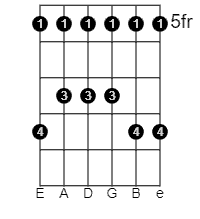
Second Position
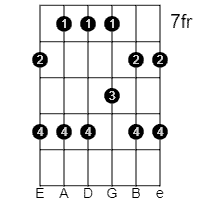
Third Position
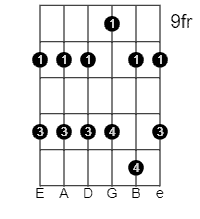
Fourth Position
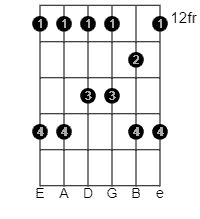
Fifth Position
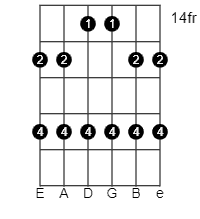
Bear in mind that you can play position five behind position one; it would be something like this:

Major vs. Minor Pentatonic
Now that you’ve seen both shapes in all their five positions, you might be scratching your head and saying… but they are the same starting from different frets!
Well, you’re absolutely right about that; these scales can be played using the same boxes in different parts of our fretboard.
This is not just a detail; it is a great asset that makes pentatonic scales so famous and widely used in the world. Yes, you can use them interchangeably and create sonic landscapes of tension, and upbeat melodies, or put a pinch of sadness to a major-chord chorus.
As a rule of thumb, though, you should use the major pentatonic with the major chords and the minor pentatonic to play over minor chords.
That being said, you can create interesting note clashes when using them the opposite way or blending notes from one to the other.
What is a blues scale?
Now that we’ve seen the pentatonic scale, and know how to form them, it is time to turn blue and explore their blues version.
First off, let’s start by giving up our big scoop: yes, blues scales are pentatonic scales with one added note. Therefore, if the pentatonic scales have five notes, the blues scales will have six notes.
When we saw the formation of a pentatonic scale, we saw that to make it we had to shorten either the major or the minor scales. We had to turn a 7-note scale into a 5-note scale.
To do this, we took the same structure and subtracted two notes; the IV and VII for the major and the II and VI for the minor. Therefore, the pentatonic only occurs in notes that are natural to the scale.
Here, we’ll do something different and the result is going to be beyond amazing. What we’ll do is add a note that is not part of the original scale.
The particularity of this add-on is that, since it wouldn’t occur naturally in the scale, gives the note a very interesting “clashing” quality that dyes every composition in a deep blue color.
It is only a note, but at the same time, it is not just any note, it is the blue note.
Are blues scales just pentatonic scales with extra notes?
You already know the answer to the question above, the answer is an absolute yes. But, let’s dive into this note that has changed music history.
The main aspect of this particular note is the fact that it doesn’t naturally occur in the scale we’re playing. This property generates a mild dissonance that works as a melodic hook that can take any composition into a different territory
Moreover, you have to be very careful how you blend that extra blue note into your playing. It is a heavily melodic note that is loaded with emotion. So, if you’re careful how you blend it in, you can create the ultimate emotional hook to bring people into your music.
On the other hand, if you overuse it, the result can be overwhelming. It’s like seasoning your food, you can’t put too much of a strong flavor or it will ruin the preparation.
The blue note is not just another note; it is a single note that can change it all.
Are there different blues scales?
Yes, just like we have a major and a minor pentatonic scale derived from the major and minor scale, we also have a major and a minor blues scale.
If you’re thinking that the major blues scale comes from the major pentatonic and the minor blues scale comes from the minor pentatonic, you’re absolutely right; congratulations.
Yes, to transform the major pentatonic scale into the major blues scale, we have to add one note. Likewise, the minor blues scale is a minor pentatonic scale with an added note.
Let’s divide this into major and minor.
The Major Blues Scale
To start turning blue, we’ll address the major blues scale first.
This scale, as we said before, is derived from the major pentatonic. We need to turn a 5-note scale into a 6-note scale.
But, what is the note we should add to form a major blues scale?
Let’s go back to our chart, the major pentatonic scale looks like this:
| I | II | III | V | VI |
| A | B | C# | E | F# |
| W | W | W+H | W | W+H |
What we have to do is add the chromatic note that will turn this into a blues scale. The interval we need is the b3 or flat third. So, the major blues scale looks something like this:
| I | II | bIII | III | V | VI |
| A | B | C | C# | E | F# |
| W | W | H | W+H | W | W+H |
As you can see, to our III or third degree we added its flat version. This note, C, is not part of our original Major Scale, it is a chromatic note.
This added chromatic note can give an extra feeling and texture to any composition.
So, the major blues scale formula looks like this:
- I (Root)
- II (Major)
- bIII (Flat)
- III (Major)
- V (Perfect)
- VI (Major)
Let’s check out what it looks like in our fretboard, expanded into its five positions.
First Position
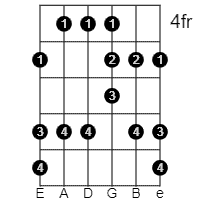
Second Position
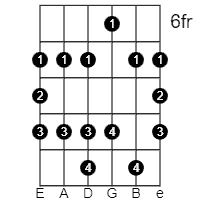
Third Position

Fourth Position
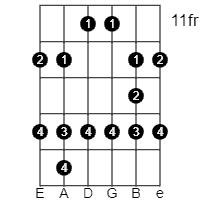
Fifth Position
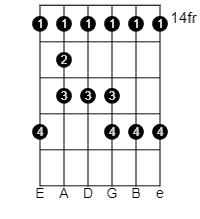
Just like it happened with the major and minor pentatonic scales, you can play position 5 before position 1 as well. It looks something like this:
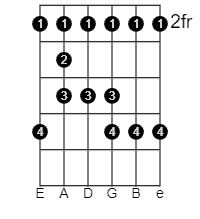
The Minor Blues Scale
Now that you know about the major version of the blues scale, it’s time to take it to the extreme. Yes, the blue note in the context of the minor blues scale takes a whole different dimension.
As you might know, minor scales, chords, and chord progressions work on the emotional side of music. Therefore, if we add to that the melodic weight of the blue note, what we have is an instant and powerful emotional melody or tune.
Let’s build this emotional powerhouse the same way we did with its major sibling.
This is the minor pentatonic:
| I | III | IV | V | VII |
| A | C | D | E | G |
| W | W | W | H | W |
The interval we have to add to it is the flat 5th (b5 or bV). So, if we use the same chart, the A minor blues scale looks something like this:
| I | III | IV | bV | V | VII |
| A | C | D | Eb | E | G |
| W | W | W | H | H | W |
This flat 5th, the Eb note, is not part of the natural A minor scale. Therefore, it is a chromatic note that adds a slight dissonance and a ton of emotion to the composition.
The formula of the minor blues scale is this:
- I (Root)
- III (Flat)
- IV (Perfect)
- bV (Flat)
- V (Perfect)
- VII (Flat)
Now let’s see it in all its five positions, its extended glory that has been making music history for decades.
First Position
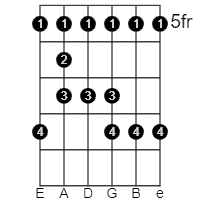
Second Position
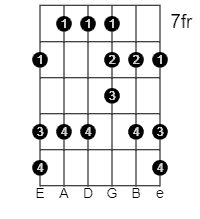
Third Position

Fourth Position
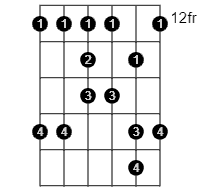
Fifth Position
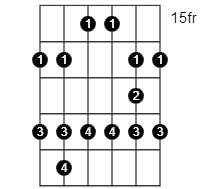
Just like with the major blues scale and the pentatonic scales, the 5th position can be played before the first and it looks something like this:

Can you use pentatonic and blues scales interchangeably?
Hey, I’m so happy you asked that question!
The answer is not only yes, the answer unlocks a full new landscape for your guitar. Yes, you can pivot from one to another to create a sense of “ace up your sleeve”.
What do I mean by this? Well, the blue note, as we said before, is a chromatic note that is heavily loaded with emotional content. So, it can engage the wow factor in your audience very easily.
Therefore, knowing exactly when to use the ace up your sleeve, can turn that blue note into a much more powerful resource in your arsenal.
Don’t worry, we’re going to talk about 12-bar blues and where to push the red button in a few paragraphs.
For now, what I want you to understand, and we’ll illustrate this with an example, is that the blue note is your extra resource, your secret sauce.
So, if you don’t overuse it and blend it in carefully, you can reach the next level of emotion in your audience.
As a rule of thumb, when you use the major pentatonic and blues scales, you’re creating an upbeat, happy feeling that is contagious and can make people dance.
On the other hand, when you sail toward minor territory, with the pentatonic or blues scale, you’ll be engaging the emotional factor, turning on the blue sign.
As you know, we became musicians to break the rules, so these will be broken in just a few paragraphs as I teach you a couple of tricks that years of stage improvisation and blues jams have given me.
So, let’s play these first licks that contain both, the pentatonic and the blues scales.
A Minor Pentatonic/Blues Scale Exercise

This is the A minor pentatonic mixed with the A minor blues scale. Please note that the blues scale appears right away with that passing note, the D# (Eb) in the 6th fret of the fifth string.
Then, we move on to the minor pentatonic and play with that until the D# appears again, this time more pronounced in the 8th fret of the third string with a repetition.
Finally, the exercise ends by going back to the minor pentatonic and finishing with the C note.
This simple exercise over a very simple, minor chord progression is a great example of how by dosing the blue note, you can add texture to an otherwise, very plain lick.
A Major Pentatonic/Blues Scale Exercise
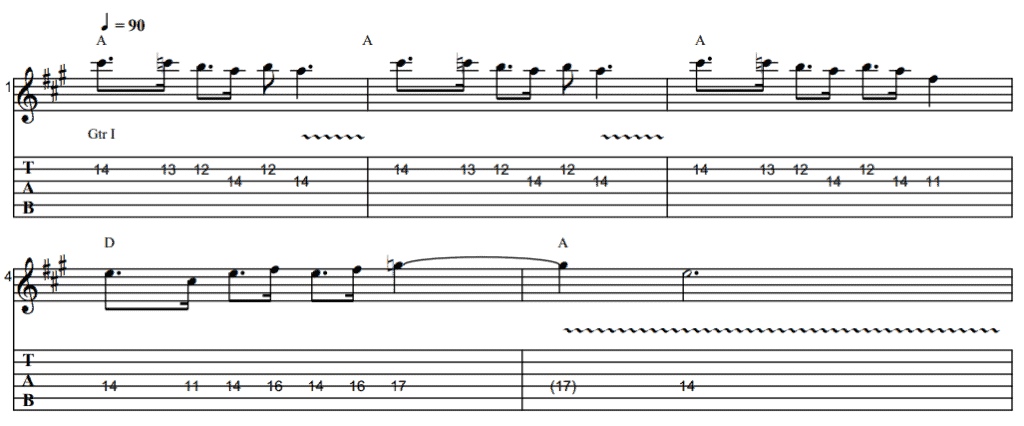
I created this exercise one octave higher so you can have fun experimenting with the wonders of playing one scale in two octaves. This, as you’ll notice is quite an upbeat lick that is played over a very simple, major chord progression.
The way of blending the blues scale and the pentatonic scale here is a little more drastic. You are using the C as a passing note toward the B in the 13th and 12th frets of the guitar.
By the end of the exercise, though, you get a very strong accent again on that C when you play it as the semi-final note on the 17th fret.
Finally, the exercise ends with an A to keep the note and the mood really high.
How to improvise with the pentatonic or blues scale?
Improvising using these scales is the name of the game for most of us, guitar players who like jamming.
As a rule of thumb, you should play a major pentatonic or blues scale over a major chord progression and a minor pentatonic or blues scale over a minor chord progression.
Yes, I know your brain is going “boooooooooooring!” but there’s a perfect technical explanation for this phenomenon.
As you might know, the minor pentatonic and blues scales have a minor third which creates a dissonance with the major third of the major chords. Here’s where we start breaking the rules because that dissonance creates tension and dynamics.
If we can make tension, dynamics, and dissonance join our team and use them wisely, we can turn plain licks into multilayered, textured playing that becomes more appealing to the listener.
That being said, this doesn’t apply so well when doing it vice-versa. Indeed, if we play a major pentatonic or blues scale over a minor chord progression, we’ll find that clash isn’t so musical, and is better to avoid it.
Yet, before we start with the exercises, we can talk about the 12-bar blues which is blues’ most common and widely played format.
The 12-bar blues follows a formula that can be resumed as I – IV – V. These intervals are preserved, regardless of the key we’re playing on.
For example, the bass player can say that we’re playing the 12-bar blues in A, for example. In that case, the chords to be used are:
- I = A
- IV = D
- V = E
Moreover, these intervals are usually played utilizing dominant 7th chords. In that case, the chord progression could be A7, D7, and E7.
Watch Out with the IV Chord
The IV chord in this chord progression contains a note that isn’t part of the major pentatonic scale. In the case of our example, the A pentatonic scale contains the C# and the D chord (or D7) contains a C.
As we saw before, the C is part of the major blues scale along with the C#. Yet, if you play the C# against the C in the chord you’ll create a not-so-beautiful dissonance that is not welcome to listeners’ ears.
So, how do we resolve this issue? Well, we can play the major blues scale throughout the 12-bar blues, and then, when we get to the IV chord, we can just move toward the minor blues scale.
The minor blues scale contains the C note that won’t clash against the chord and will sound more musical.
Let’s make an example over a 12-bar blues in A.
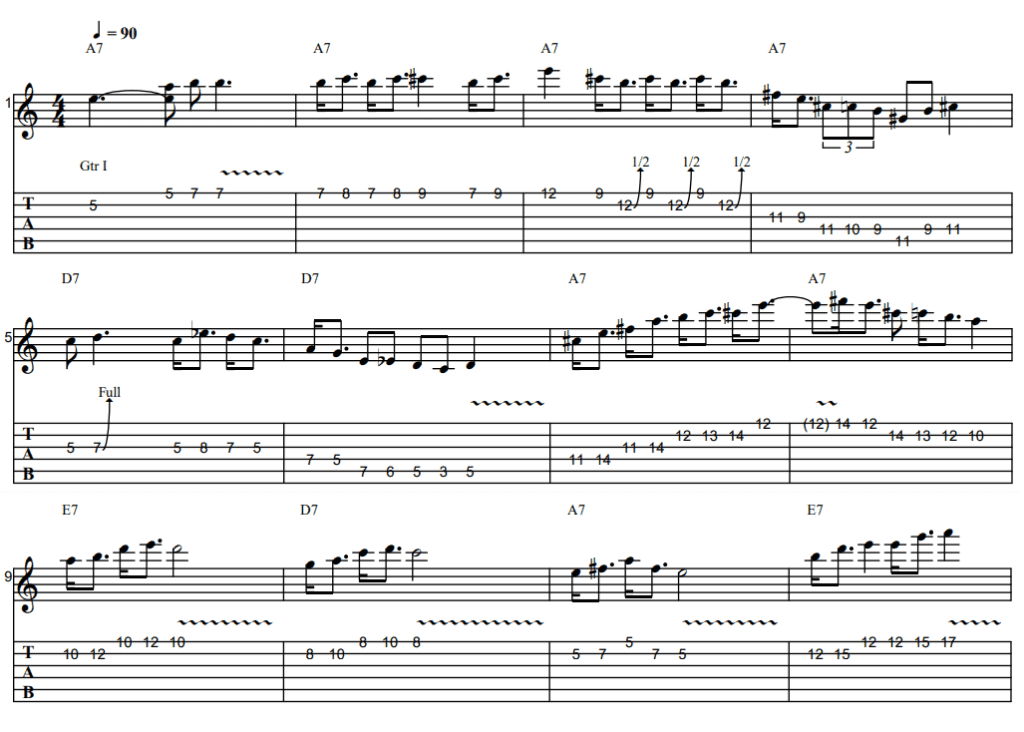
This exercise shows exactly what you can do with the major and minor blues scales and there’s an added bonus.
But let’s break it down into its parts.
Over the A7, because it is a dominant seventh chord, you can play either major or minor. I chose the major blues scale to give the exercise more of an upbeat thing.
Now, by the time the progression reaches the IV chord, I modulated to minor so I could make the clash between chords and notes less abrupt and add a sense of movement to the lick.
The moment it really gets interesting is when the progression gets to the V chord because I used the A note as a pivotal note to move to the E minor pentatonic as a small modulation.
Then, that same pattern repeats again in the A minor pentatonic scale for the IV chord, then back to the major for the A7, and it ends with a small lick in the E minor pentatonic resolving to the root note A.
In this small example, you can see that we can go back and forth from one scale to another, from major to minor, modulate to a different scale, and keep it all sounding in tune and in key.
Go on, play it many times and steal those tricks, use them a lot, give them your personality, and have fun!
Key Takeaways of this Exercise
- Over dominant seventh chords, you can play either the major or the minor blues or pentatonic scales. Whichever you choose is going to set the mood for the improvisation.
- Avoid playing the major pentatonic or blues scales over the IV chord of the progression to elude nasty note clashes.
- If you want to, you can modulate to the V chord scale when the time comes to create even more movement in the lick. Otherwise, you can stick to the same scale you have been using in the previous bars.
Over which chords can you use the blues or pentatonic scale?
I’m so glad you also asked this because it is one of the main reasons why learning these scales is paramount for a modern guitar player!
The answer is that except in a stricter jazz environment or other kinds of traditional music, you can play pentatonic scales over everything. Yes, that’s one of the reasons why they are such a part of our life’s soundtrack; they go well with everything.
Now, the blues scale is a different deal. Yes, both, the major and the minor blues scales are loaded with a note that sounds undoubtedly blue.
So, for example, if you’re trying to build a very upbeat funky riff, the blues scale (major or minor) will be kind of an anchor taking your song away from the dance floor and into the emotional realm.
On the other hand, we’re making music and we love to break the rules. So, as long as you don’t find it dissonant in a nasty way, that is an approach you can also pursue with the blues scale.
There are many examples of minor blues scales working wonderfully well over a major chord progression.
But let’s make it official, and divide the blues scales into the chords you can play them over:
The Minor Blues Scale Can Be Played On
- Major
- Minor
- 9th
- 13th
- m6
- m9
- m11
- Maj6
- Maj7
- Maj9
The Major Blues Scale Can Be Played On
- Major
- 7th
- 9th
- 13th
- Maj6
- Maj9
The Bottom Line
We’ve reached the end of this in-deep lesson over four of the most widely used scales in the history of modern music. These scales will allow you to play over most songs and jam on virtually any stage (unless you go to tango, jazz, bossa nova, or gypsy jams!).
So, learn them in all their variations and glory, and dare to cover the entire fretboard with mind-blowing new riffs and solos.
These scales are the building blocks of what most of us know as music. Play them, learn them, use them, and transform them into a core part of your playing.
Most importantly, have fun while learning to be a better guitarist.
Happy playing!

Hello there, my name is Ramiro and I’ve been playing guitar for almost 20 years. I’m obsessed with everything gear-related and I thought it might be worth sharing it. From guitars, pedals, amps, and synths to studio gear and production tips, I hope you find what I post here useful, and I’ll try my best to keep it entertaining also.





